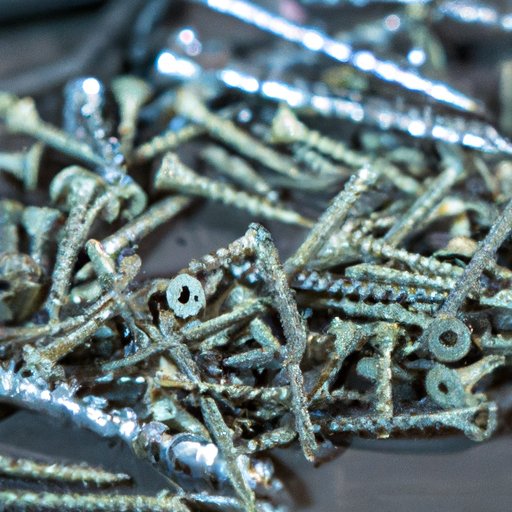Introduction
If you’ve ever worked on a project that requires removing screws, you know how frustrating it can be to encounter a stripped screw. A stripped screw is one that has been damaged so that the cross-shaped indentation in the head no longer allows a screwdriver or drill bit to grip it properly. In this article, we’ll explore the different methods you can use to remove stripped screws. We’ll break down each method step-by-step and offer tips for success. By the end, you’ll have the knowledge and confidence to tackle even the most stubborn stripped screws.
Use Rubber Bands
One of the easiest and most common methods for removing stripped screws is to use a rubber band. The rubber band acts as a grip between the screwdriver or drill bit and the stripped screw, allowing you to apply enough pressure to remove it.
Step 1: Place a rubber band over the stripped screw.
Step 2: Place your screwdriver or drill bit over the rubber band.
Step 3: Apply pressure while turning the screwdriver or drill bit counter-clockwise to remove the screw.
Tips for success: Use a thick rubber band for better grip. If the screwdriver or drill bit slips, try a different rubber band as the first one may be worn out.
Possible drawbacks: This method may not work on screws that are too small or too large for a rubber band to fit over. The rubber band may also slip, causing the screwdriver or drill bit to slip as well.
Try Pliers
If the rubber band method doesn’t work, you can try using pliers to remove the stripped screw.
Step 1: Grip the head of the stripped screw with a pair of pliers.
Step 2: Apply pressure while turning the pliers counter-clockwise to remove the screw.
Tips for success: Use pliers that have a good grip. If the head of the stripped screw is too small, try needle-nose pliers.
Possible drawbacks: Pliers can damage the head of the stripped screw, making it harder to remove.
Use a Screw Extractor Kit
For more stubborn stripped screws, a screw extractor kit may be necessary. These kits come with a drill bit and extractor tool designed to remove stripped screws.
Step 1: Drill a small hole in the center of the stripped screw head using the drill bit in the kit.
Step 2: Switch to the extractor tool and insert it into the hole you made in step 1.
Step 3: Apply pressure while turning the extractor counter-clockwise to remove the screw.
Tips for success: Use a low-speed drill to avoid damaging the surrounding material. Follow the instructions on your screw extractor kit carefully.
Possible drawbacks: Screw extractor kits can be expensive. The extractor tool may also break off inside the stripped screw, making it even harder to remove.
Tap the Screwdriver
Another method for removing stripped screws is to tap the end of the screwdriver with a hammer, creating a better grip on the screw head. This method works best with screws that aren’t completely stripped.
Step 1: Place your screwdriver into the stripped screw head.
Step 2: Tap the end of the screwdriver with a hammer several times.
Step 3: Apply pressure while turning the screwdriver counter-clockwise to remove the screw.
Tips for success: Use a screwdriver with a good grip. Tap gently to avoid damage to surrounding material.
Possible drawbacks: This method is less effective with completely stripped screws. Tapping too hard can damage the surrounding material.
Apply Heat
Heat can help to expand the surrounding material, making it easier to remove a stripped screw. This method works best with screws that are stuck due to rust or corrosion.
Step 1: Heat the screw and surrounding area with a heat gun or blow dryer for a few minutes.
Step 2: Place your screwdriver into the stripped screw head.
Step 3: Apply pressure while turning the screwdriver counter-clockwise to remove the screw.
Tips for success: Be careful not to overheat the surrounding material. Use heat-resistant gloves to protect your hands.
Possible drawbacks: This method can be dangerous if not done properly. It may also damage the surrounding material.
Use a Dremel Tool
A Dremel tool is a rotary tool with multiple attachments. It can be used to cut through surrounding material in order to access the stripped screw.
Step 1: Choose a cutting attachment for your Dremel tool.
Step 2: Make a cut in the surrounding material to access the stripped screw.
Step 3: Place your screwdriver into the stripped screw head.
Step 4: Apply pressure while turning the screwdriver counter-clockwise to remove the screw.
Tips for success: Use the appropriate cutting attachment for the material you’re working with. Work slowly and carefully to avoid damaging surrounding materials.
Possible drawbacks: Dremel tools can be expensive. This method can also damage surrounding materials if not done properly.
Conclusion
Removing stripped screws can be a frustrating and time-consuming task, but with these methods, it doesn’t have to be. Each of the seven methods outlined in this article offers a different approach to solving the problem of stripped screws. It’s important to choose the method that’s right for your situation, based on the size of the stripped screw, the material it’s in, and the tools you have available. By being prepared with a variety of methods and problem-solving skills, you can tackle any project with confidence.
Review of pros and cons: The rubber band, pliers, and tapping methods are relatively inexpensive and easy to use. The screw extractor kit, applying heat, and using a Dremel tool require more specialized tools but offer more effective solutions for stubborn stripped screws.
Final thoughts: Remember to take your time and use caution when removing stripped screws. With patience and persistence, you can overcome even the most challenging projects.
